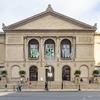More about Cliff Walk at Pourville

Contributor
The Cliff Walk is one of a series of works that Monet painted when he was just trying to get away from it all.
It was not looking like the 1880s were going to treat the artist well. His wife had died right before the beginning of the decade, and, at the same time, France was in the midst of an extended depression that was affecting Monet’s sales. In fact, most of Europe was out of sorts trying to navigate what would later come to be called the Long Depression. As a result, Monet booked a trip to Normandy to enjoy the scenic beaches. Apparently they were so scenic that he would decide to spend the last 30 years of his life on the coast.
Considering how poorly things were going for him, one would think that the artist would want to paint something other than reality. However, Monet is the Impressionist of Impressionists, and capturing the here-and-now is exactly what Impressionism is all about. The style avoided the more dramatic elements associated with Romanticism and the historical bent of Neoclassicism, instead favoring images of every day life for the leisure class. In fact, the movement was so committed to capturing the real world that a good majority of the works were done plein air, or outdoors.
It's interesting to consider the correlation between national economic hardship and styles of art that depict the world "as is." In the same way that the Long Depression was the setting that produced Impressionism, forty years later, during the Great Depression, the art world would once again drift towards realism. After a period where Expressionism was riding high with paintings like The Scream, and the works of Pablo Piccaso, we see a pivot in American art to images of the mundane and average, like American Gothic and Gas.
Sources
- Vitali, Marc “Turbulence of America in 1930s Gives Rise to Distinct Artistic Voices” wttw.com 07/05/16 https://news.wttw.com/2016/07/05/turbulence-america-1930s-gives-rise-di…
- Web Contributor “The Case for Impressionism” The Art Assignment 10/17/19 https://www.youtube.com/watch?v=_tw51Eh9vcw
- Web Contributor “Monet in Normandy” Cleveland Museum of Art 02/18/07 https://www.clevelandart.org/exhibitions/monet-normandy#:~:text=Monet%2…
Featured Content
Here is what Wikipedia says about The Cliff Walk at Pourville

The Cliff Walk at Pourville is an 1882 painting by the French Impressionist painter Claude Monet, displayed in the Art Institute of Chicago. It is one in a series of landscape paintings by Monet during his time in Normandy. It depicts two girls atop a cliff overlooking the sea in fishing village Pourville, in a scene of summer sunshine and brisk breeze which juxtaposes leisure and labor by contrasting the bourgeois figures with fishing boats on the horizon.
Check out the full Wikipedia article about The Cliff Walk at Pourville












